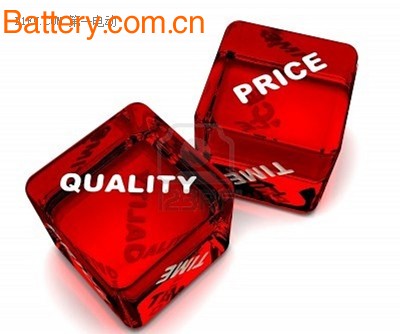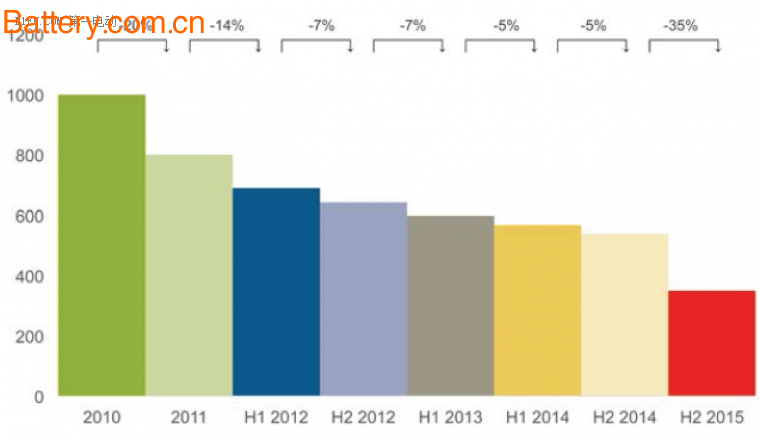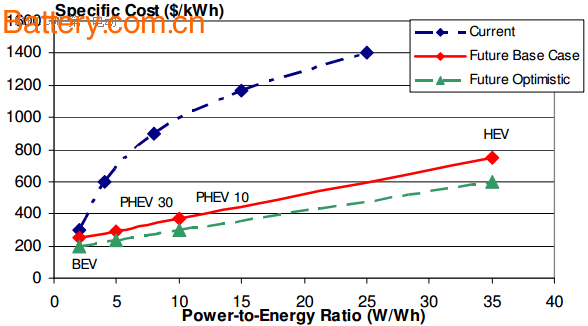At present, the high-growth new energy vehicle situation is inseparable from the subsidy policy that has caused major manufacturers to worry about the cost. The cost has become one of the important factors that hinder the further development of new energy electric vehicles . As an energy storage system for electric vehicles , the power battery The cost or price has always been a concern of both manufacturers and consumers. In fact, the cost of power batteries has dropped a lot in the past few years.

According to a study by the Frankfurt School of Finance, the cost of power batteries for 2010-2015 has been declining (Figure 1), with average costs falling by 35% in 2014-2015. There are many ways to reduce costs, such as improving battery materials, improving manufacturing processes, economies of scale, etc. These methods also play an important role in reducing the cost of consumer batteries. The study also mentioned that some large-scale power battery companies will develop some aggressive pricing (aggressive pricing) strategies to suppress competitors by sacrificing short-term profits, which also contributed to the forced decline of industry costs to a certain extent.

Figure 1 Average cost of power batteries (US$/kWh) and annual cost change for 2010-2015
In 2015, GM disclosed that the Bolt electric vehicle uses LG Chem's battery, and the price of the cell is about $145/kWh. At the annual global business conference, GM further demonstrated the cost projections for Bolt's battery cells (Figure 2). The cost in 2016 is $145/kWh, which lasts until 2019 and will drop to $120/kWh in 2020. By 2022, this number continues to drop to $100/kWh. It is said that LG Chem's price to GM is much cheaper than other manufacturers.

Figure 2 Bolt's cell cost forecast
The Argonne National Laboratory studied the relationship between the cost of 66Ah and 99Ah lithium iron phosphate LFP batteries and production (Fig. 3). The research shows that the cost of the two batteries is basically the same as the increase in output, but the cost of large batteries is high. It costs less than a small capacity battery.

Figure 3 Battery production versus cost curve
Similarly, in order to adapt to different application requirements, the performance requirements of the battery are also different, which will also have different requirements for battery manufacturing, resulting in a difference in manufacturing costs. For example, a study by the Massachusetts Institute of Technology (MIT) shows that the cost of producing high-power batteries is higher, probably because in order to achieve higher power requirements, it is necessary to design thinner battery pole pieces with a thicker thickness. Thin battery pole pieces are designed and manufactured at a higher cost than conventional pole pieces (Figure 4).

Figure 4 Relationship between cost and power-to-energy ratio (P/E)
According to Automotive Industry Association data show that in 2016 China's new energy automobile production 517,000, 507,000 sales, which BEV electric car sales were completed 417,000 and 409,000, respectively; plug-in hybrid (PHEV) sales were Completed 99,000 vehicles and 98,000 vehicles. Among them, the passenger car field: pure electric passenger car production and sales completed 263,000 and 257,000 respectively; plug-in hybrid passenger cars completed 81,000 and 79,000 respectively. In 2016, sales of new energy electric vehicles reached a record high. Taken together, various factors affecting costs, at the current stage of rapid development of power batteries, large-scale economic effects will play an important role in the decline of costs.
Fluorine material pump, as its name implies, is a pump lined with fluorine plastic. According to its structure, it can be generally divided into: fluorine-lined Centrifugal Pump, fluorine-lined Magnetic Pump, and fluorine-lined self-priming pump. The fluorine-lined pump body adopts advanced production technology and is made of metal shell lined with fluorine plastics (F46, F4, etc.), and the load-bearing part of the pump is made of metal material, which has the advantages of high mechanical strength, strong pressure resistance, and superior mechanical impact resistance; The impeller, pump cover, etc. of the main flow components are all made of metal inserts and fluorine plastics covered by one-time high-temperature molding. And acid addition process, electrolyte transportation in non-ferrous metal smelting, pickling process in automobile manufacturing, and pharmaceutical, petroleum, electroplating, dyes, pesticides, paper, food and other industries, long-term under the temperature conditions of -20 ℃ ~ 150 ℃ Transport any concentration of sulfuric acid, hydrochloric acid, hydrofluoric acid, nitric acid, aqua regia, strong alkali, strong oxidant and other strong corrosive media without damage.
Fluoroplastic Pump,Fluoroplastic Chemical Pump,Fluoroplastic Chemical Centrifugal Pump,Acid Alkali Centrifugal Pump
Jiangsu Qiantu Trading Co., Ltd. , https://www.pumpqt.com